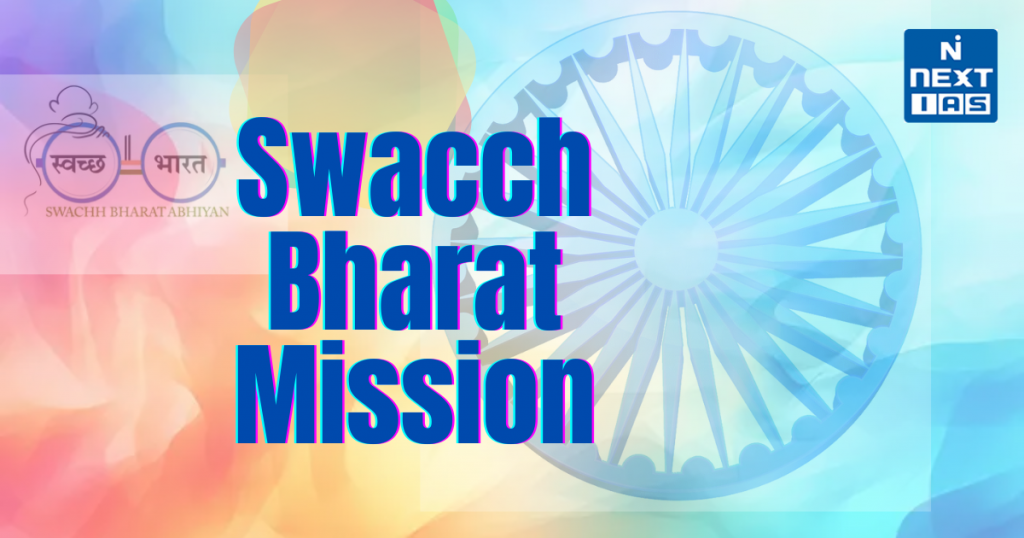
A clean India would be the best tribute India could pay to Mahatma Gandhi on his 150 birth anniversary in 2019,” said Shri Narendra Modi as he launched the Swachh Bharat Mission at Rajpath in New Delhi. On 2nd October 2014, Swachh Bharat Mission was launched throughout length and breadth of the country as a national movement. The campaign aims to achieve the vision of a ‘Clean India’ by 2nd October 2019.
About Swachh Bharat Mission
- The Government launched Swachh Bharat Mission (Gramin) on 2nd October, 2014 to accelerate efforts to achieve universal sanitation coverage, improve cleanliness and eliminate open defecation in India by 2nd October 2019.
- The program is considered India’s biggest drive to improve sanitation, hygiene and cleanliness in the country.
- The effectiveness of the Programme is predicated upon generating demand for toilets leading to their construction and sustained use by all the household members.
- It also aims to promote better hygiene behaviour amongst the population and improve cleanliness by initiating Solid and Liquid Waste Management (SLWM) projects in the villages of the country.
- This is to be bolstered with adequate implementation capacities in terms of trained personnel, financial incentives and systems and procedures for planning and monitoring.
- The emphasis is on stronger focus on behaviour change intervention including interpersonal communication; strengthening implementation and delivery mechanisms down to the GP level; and giving States flexibility to design delivery mechanisms that take into account local cultures, practices, sensibilities and demands.
Features of Swachh Bharat Mission
- Elimination of Open Defecation – The mission aims to make India open defecation-free (ODF) by constructing individual household latrines (IHHLs), community toilets, and public toilets in urban and rural areas.
- Solid Waste Management – Emphasis is placed on efficient waste collection, segregation, transportation, processing, and disposal through waste-to-energy projects and composting.
- Behavioral Change and Public Awareness – The campaign promotes hygiene awareness through mass media, educational programs, and community participation to instill cleanliness as a habit.
- Urban and Rural Implementation – SBM is divided into Swachh Bharat Mission (Gramin) for rural sanitation and Swachh Bharat Mission (Urban) for urban cleanliness and waste management.
- Use of Technology – The mission incorporates technology for real-time monitoring, geo-tagging of toilets, and tracking progress through mobile apps and dashboards.
- Involvement of Private Sector and NGOs – Public-private partnerships (PPPs) and corporate social responsibility (CSR) initiatives play a crucial role in funding and implementation.
- Focus on Sustainability – Ensuring long-term cleanliness through proper maintenance of sanitation infrastructure and promoting sustainable practices like waste segregation and recycling.
- Financial Support – The government provides financial assistance and incentives to households and local bodies for toilet construction and waste management projects.
Objectives of Swachh Bharat Mission
- Eliminating Open Defecation – The primary goal of SBM is to eradicate open defecation by constructing individual household toilets, community toilets, and public toilets.
- Improving Sanitation Infrastructure – SBM promotes the construction of toilets, sewage treatment facilities, and waste management systems to enhance sanitation coverage.
- Behavioral Change and Awareness – The mission encourages hygiene awareness and behavioral change through campaigns, school programs, and community involvement.
- Solid and Liquid Waste Management – SBM emphasizes efficient waste collection, segregation, recycling, and safe disposal to maintain cleanliness in urban and rural areas.
- Sanitation Coverage in Rural and Urban Areas – The program aims to provide sanitation facilities to all households, schools, and public places, ensuring hygiene for all citizens.
- Encouraging Public Participation – Swachh Bharat promotes citizen engagement, corporate participation, and NGO involvement to sustain cleanliness efforts.
- Sustainability and Environmental Protection – SBM promotes eco-friendly practices such as waste-to-energy projects, biogas generation, and scientific waste disposal to ensure long-term sustainability.
Significance of Swachh Bharat Mission
- The Swachh Bharat Mission (SBM) is one of India’s most significant cleanliness initiatives, launched on October 2, 2014, to achieve universal sanitation coverage and eliminate open defecation. This mission has played a transformative role in improving public health, environmental sustainability, and overall quality of life.
- One of the primary achievements of SBM has been the construction of millions of toilets, especially in rural areas, ensuring better sanitation facilities and reducing waterborne diseases. By focusing on behavioral change through awareness campaigns, it has encouraged individuals and communities to adopt hygienic practices, thereby promoting cleanliness as a way of life.
- The mission also addresses solid waste management, encouraging waste segregation, recycling, and scientific disposal methods. It has driven urban and rural local bodies to implement better sanitation infrastructure, reducing pollution and fostering cleaner cities and villages.
- Apart from health benefits, SBM has had a positive socio-economic impact, particularly empowering women and marginalized communities by providing access to safe and private sanitation facilities. Improved sanitation has also contributed to increased school attendance among girls.
- Moreover, the initiative has inspired citizen participation, corporate involvement, and technological innovation in waste management. It aligns with the United Nations Sustainable Development Goals (SDGs), especially Goal 6 (Clean Water and Sanitation).
- While significant progress has been made, continuous efforts are required to maintain cleanliness, enhance waste management systems, and ensure long-term sustainability. Swachh Bharat Mission has not only improved sanitation but has also instilled a collective sense of responsibility toward a cleaner and healthier India.
Lacunae of Swachh Bharat Mission
- The Swachh Bharat Mission (SBM) has significantly improved sanitation and hygiene across India, yet several lacunae hinder its full success. One major issue is sustainability—while toilets have been built in large numbers, many lack proper maintenance, water supply, and regular use. In several areas, toilets remain unused due to poor construction quality or behavioral resistance, highlighting the need for sustained awareness campaigns.
- Another challenge is waste management. While SBM promotes cleanliness, solid and liquid waste management systems remain weak. Many urban and rural areas still struggle with improper garbage disposal, lack of waste segregation, and inefficient recycling infrastructure. Open dumping and burning of waste continue to be common practices.
- Behavioral change remains a critical issue. Despite awareness programs, deep-rooted habits of open defecation persist in some communities. Changing social norms requires long-term engagement rather than short-term campaigns.
- Additionally, urban sanitation challenges persist due to rapid urbanization. Slums and overcrowded settlements often lack proper sanitation facilities, making implementation difficult.
- Funding and administrative gaps also pose issues. While SBM received significant government investment, there have been reports of funds being misused or inadequately allocated, affecting the mission’s efficiency.
- Lastly, the mission faces inequality in access, as marginalized communities often lack adequate sanitation due to social and economic barriers.
- To ensure long-term success, SBM needs a stronger focus on behavioral change, infrastructure maintenance, waste management, and inclusive sanitation policies.
Key Pointers for Swachh Bharat Mission (SBM) relevant for UPSC CSE Prelims
Launch & Objective
- Launched on October 2, 2014 by PM Narendra Modi.
- Aim: To achieve Open Defecation Free (ODF) India and improve sanitation & waste management.
Components
- SBM-Gramin (SBM-G): Rural sanitation, individual household latrines (IHHL), community toilets.
- SBM-Urban (SBM-U): Solid waste management, scientific disposal, sanitation infrastructure.
Phases
- Phase 1 (2014–2019): Focused on making India ODF.
- Phase 2 (2020–2025): ODF+ and ODF++ for sustainability & waste management.
Key Features
- ODF, ODF+, ODF++ Certification: Levels of sanitation achievement.
- Behavioral Change: Swachhagrahis, mass campaigns.
- Waste Management: Plastic waste, fecal sludge management, bio-toilets.
- Financial Support: Incentives for toilet construction via Direct Benefit Transfer (DBT).
Related Initiatives
- GOBAR-Dhan Scheme: Bio-energy from waste.
- Jal Jeevan Mission: Clean drinking water & sanitation.
- Swachh Survekshan: Annual cleanliness ranking of cities.
Way Forward
To sustain Swachh Bharat Mission’s success, focus on waste segregation, efficient solid waste management, and behavioral change. Strengthening rural sanitation, leveraging technology, and enforcing stricter waste disposal regulations are key. Public participation, corporate partnerships, and sustainable funding will ensure long-term cleanliness and environmental health across India.
Conclusion
Swachh Bharat Mission has significantly improved sanitation, waste management, and hygiene across India, making it ODF. While it has fostered behavioral change and public participation, challenges like waste processing and sustainability remain. Continued efforts are essential to maintain cleanliness, ensure environmental sustainability, and achieve a truly Swachh Bharat.





